Recommended Books:
Below are some recommended reads for those interested in learning more about building and nurturing positive relationships in the classroom.
Student Voices & Advice
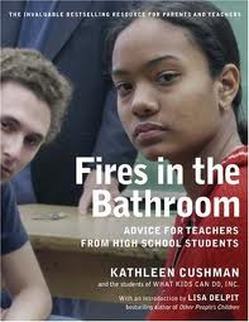
Cushman, K. & L. Delpit. (2003). Fires in the Bathroom: Advice for Teachers from High School Students. New York: The New York Press.
Cushman’s book provides a unique glimpse into students’ voices, stories and conversations on ideas such as school, teachers and life. This book provides an opportunity for new and aspiring teachers to gain insight into teaching from the people most affected by their success or failure. It is also a catalyst for experienced teachers to rethink their craft and to use the words of the students in the book to initiate conversations with their own students.
Cushman’s book provides a unique glimpse into students’ voices, stories and conversations on ideas such as school, teachers and life. This book provides an opportunity for new and aspiring teachers to gain insight into teaching from the people most affected by their success or failure. It is also a catalyst for experienced teachers to rethink their craft and to use the words of the students in the book to initiate conversations with their own students.
Classroom Management & Support
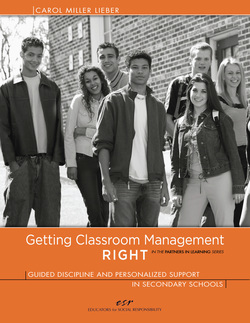
Lieber, C.M. (2009). Getting Classroom Management Right: Guided discipline and personalized support in secondary schools. Cambridge, MA: Educators for Social Responsibility.
This books is chalked full of classroom management techniques, tips and practical advice.The introduction chapter begins discussing three typical approaches to classroom management: the punitive approach, the do-nothing approach and the guided discipline approach. Chapter 2 lays out 13 guided discipline scenarios which illustrate how punitive, do nothing and guided discipline approaches result in differing outcomes for the student, the teacher, and the group. The scenarios beg two questions: How would you describe the problem type and what set of responses, consequences, and interventions might be most effective in this situation? the third chapter premises effective classroom management and cohesiveness on knowing yourself, knowing your students and knowing your school. In the last chapter, Lieber describes two essential components of effective classroom management: how you manage activities and pace lessons to maximize student engagement, and how you use effective “teacher talk” to invite cooperation and self-correction when problematic behaviors occur.
This books is chalked full of classroom management techniques, tips and practical advice.The introduction chapter begins discussing three typical approaches to classroom management: the punitive approach, the do-nothing approach and the guided discipline approach. Chapter 2 lays out 13 guided discipline scenarios which illustrate how punitive, do nothing and guided discipline approaches result in differing outcomes for the student, the teacher, and the group. The scenarios beg two questions: How would you describe the problem type and what set of responses, consequences, and interventions might be most effective in this situation? the third chapter premises effective classroom management and cohesiveness on knowing yourself, knowing your students and knowing your school. In the last chapter, Lieber describes two essential components of effective classroom management: how you manage activities and pace lessons to maximize student engagement, and how you use effective “teacher talk” to invite cooperation and self-correction when problematic behaviors occur.
Teacher Responsibility for Student Development
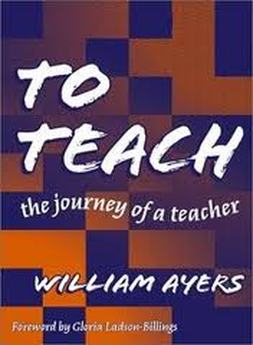
Ayers, W. (2001). To Teach: The Journey of a Teacher. New York, NY: Teachers College Press.
To Teach is the story of one teacher’s odyssey into the ethical and intellectual heart of teaching, and at the same time an invitation to teachers to more thoughtfully and carefully map their own pathways. This second edition offers new resources and addresses the small schools movement, as well as new challenges facing teachers. In conceptual and practical ways, To Teach narrates an essential journey all teachers must take if , at the end of their own Yellow Brick Roads, they are to achieve the basics: a heart, a brain, the nerve, and a home. This engaging volume provides:
Inspiration to teachers who want to reconnect with their highest aspirations and hopes
A practical guide to teaching as a moral practice
An antidote to teaching as a linear, connect-the-dots enterprise
A study guide for readers that is available on-line at teacherscollegepress.com
To Teach is the story of one teacher’s odyssey into the ethical and intellectual heart of teaching, and at the same time an invitation to teachers to more thoughtfully and carefully map their own pathways. This second edition offers new resources and addresses the small schools movement, as well as new challenges facing teachers. In conceptual and practical ways, To Teach narrates an essential journey all teachers must take if , at the end of their own Yellow Brick Roads, they are to achieve the basics: a heart, a brain, the nerve, and a home. This engaging volume provides:
Inspiration to teachers who want to reconnect with their highest aspirations and hopes
A practical guide to teaching as a moral practice
An antidote to teaching as a linear, connect-the-dots enterprise
A study guide for readers that is available on-line at teacherscollegepress.com
Teacher Responsibility for Student Development: A Comic Journey
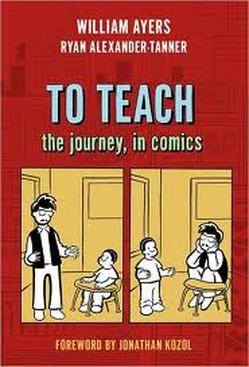
Ayers, W. & R. Alexander-Tanner (2010). To Teach: The Journey, In Comics. New York, NY: Teachers College Press.
Bill Ayers and Ryan Alexander-Tanner collaborated on this nonfiction graphic novel, To Teach: The Journey, in Comics, a plea for smaller classes, better resources for teachers, and standards that push students without punishing them. An accompaniment to To Teacher: The Journey of a Teacher. The presentation of Ayers’s ideas in the medium of a graphic memoir is so engaging that many may miss how innovative his thinking is unless we recall our own educational experiences, when exciting classes and great teachers were the exception and boring classes, uninspired instruction and clocks whose hands never seemed to move were the norm. The approaches that Ayers advocates spring not from theory but from the real-world experience of many teachers who strive to create classrooms for active learning. “All teachers must become students of their students,” he proclaims in his call for observing each child as an individual in the classroom; one size does not fit all when it comes to learning.
Bill Ayers and Ryan Alexander-Tanner collaborated on this nonfiction graphic novel, To Teach: The Journey, in Comics, a plea for smaller classes, better resources for teachers, and standards that push students without punishing them. An accompaniment to To Teacher: The Journey of a Teacher. The presentation of Ayers’s ideas in the medium of a graphic memoir is so engaging that many may miss how innovative his thinking is unless we recall our own educational experiences, when exciting classes and great teachers were the exception and boring classes, uninspired instruction and clocks whose hands never seemed to move were the norm. The approaches that Ayers advocates spring not from theory but from the real-world experience of many teachers who strive to create classrooms for active learning. “All teachers must become students of their students,” he proclaims in his call for observing each child as an individual in the classroom; one size does not fit all when it comes to learning.
Classroom Management
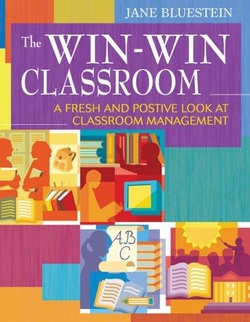
Bluestein, Jane (2007). The Win-Win Classroom: A Fresh and Positive Look at Classroom Management.
Dr. Jane Bluestein is a former inner-city teacher whose book is a how-to guide for new teachers on building a successful career. Included are tips for pro-active, positive classroom management skills, reducing the need for teachers to resort to authoritarian-style classroom management. She provides examples of both good and bad managerial styles in order provide a clear constrast for those new to teaching. Also included is a detailed, realistic outline of the pros and cons of choosing teaching as a career, how to create a personal survival guide, and options for furthering one's career. Each chapter ends with work book style questions that encourage the reader to carefully consider the presented information, providing a more personalized experience with the text. This book is very thoughtful towards brand new teachers, helping to recognize and carefully consider some of the many crucial factors that can make or break one's overall teaching experience.
Dr. Jane Bluestein is a former inner-city teacher whose book is a how-to guide for new teachers on building a successful career. Included are tips for pro-active, positive classroom management skills, reducing the need for teachers to resort to authoritarian-style classroom management. She provides examples of both good and bad managerial styles in order provide a clear constrast for those new to teaching. Also included is a detailed, realistic outline of the pros and cons of choosing teaching as a career, how to create a personal survival guide, and options for furthering one's career. Each chapter ends with work book style questions that encourage the reader to carefully consider the presented information, providing a more personalized experience with the text. This book is very thoughtful towards brand new teachers, helping to recognize and carefully consider some of the many crucial factors that can make or break one's overall teaching experience.
Teaching with Love and Logic

Fay, J. & Funk, D. (1998). Teaching With Love & Logic: Taking Control of the Classroom. Golden, CO: Love & Logic Institute, Inc.
The teacher's version of the popular parenting book. Fay and Funk present inspirational, logical, and manageable approaches to creating and maintaining a relationship and learning-friendly classroom. This book is popular and time-tested.
The teacher's version of the popular parenting book. Fay and Funk present inspirational, logical, and manageable approaches to creating and maintaining a relationship and learning-friendly classroom. This book is popular and time-tested.
